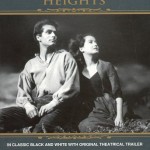“Wuthering Heights” (1939) Oberon/Olivier

Because I am an obsessive nerd, I am preparing for my book discussion of Wuthering Heights by watching as many of its film/tv adaptations as I’m able. Also because I’m an obsessive nerd, I’m trying to watch them in order, guessing that later adapters were influenced by earlier ones.
I began with what is the earliest widely available, and perhaps best known, adaptation, Wuthering Heights (1939) directed by William Wyler, with Laurence Olivier as Heathcliff, and Merle Oberon as Cathy 1. The film doesn’t include the second generation, though “Mrs. Heathcliff” does appear in the opening scenes, sitting sullenly by the fire when Lockwood foists himself on Wuthering Heights.
Tagline: A servant in the house of Wuthering Heights tells a traveler the unfortunate tale of lovers Cathy and Heathcliff.
This adaptation has the same problem as many subsequent ones. The book shows the characters at three major stages: childhood, early teens, and late teens. Heathcliff and Cathy are approximately the same age. Cathy dies giving birth to little Cathy when she is only 19. Yet Olivier was 32 and Oberon 28 when the film was released, and they play Cathy and Heathcliff for the early/late teen parts. The iconic photo of them on the moors shows two adults, rather then the two approximately 15 year olds. The introduction to the Oxford World’s Classic edition of WH I read says that the scene it depicts isn’t in the book. I differ and argue that it does depict from the book, only with actors so much older that it skews the effect.
Here’s what didn’t work for me, things that tend to coincide with things that depart from the book. The actors in general were older than in the book, especially Lockwood (who is supposed to be a young city dandy) and Nellie (supposed to be the same age as Hindley). The movie retreats from the gruesome, violent image of Lockwood dragging the ghost’s wrist over broken glass, which I think helps set up the story as a ghost and horror tale as well as a love story. Heathcliff before he runs away is handsome and well-spoken, barely scruffed up.
What did work: I liked that they used the framing device of Lockwood and Nellie, and don’t mind that they omitted the second generation. Though it’s necessary to the book, a movie two hours or less has sacrifices to make, and if you’re only going to tell the story of Cathy and Heathcliff, then do it and do it well. To contrast, I felt the 1992 Kosminky adaptation with Binoche and Fiennes tried to cram too much in.
Olivier when he returns as Heathcliff is mesmerizing and handsome and compelling. I liked Oberon’s haughty spirit and ferocity as Cathy. This may have been because she despised Olivier. According to the IMDB trivia:
Merle Oberon and Laurence Olivier apparently detested each other. Legend has it that when William Wyler yelled “Cut!” after a particularly romantic scene, Oberon shouted back to her director about her co-star “Tell him to stop spitting at me!”
I also liked Niven as Edgar Linton. I thought he was both effete yet handsome and strong enough of an actor to carry off what is often a thankless role.
The more adaptations I watch, the more I like this one. It’s not perfect, none of them are, but it’s reasonably faithful to part of the book especially the wild spirit of it, the acting is strong, the look is distinct, and in general it’s a enjoyable and well-made film to watch.
For more Wuthering Heights goodness, including a good compare/contrast of many of the adaptations, visit The Readers Guide to Wuthering Heights UK.
And for all the Bronte news you can shake a stick at, visit Bronte Blog.
November 26th, 2014 at 1:33 pm
I find age to be a problem in many adaptations of this kind. The worst is Emma. One of the reasons why Mr Knightley is an unlikely object of love is, I think, that he is much older than Emma. And yet most adaptations don’t show this age difference. Think of Jeremy Northam and Gwineth Paltrow…
November 30th, 2014 at 11:02 am
I think age is a huge factor in casting, and the adaptations that work best for me get it closest. I’m fascinated that in the adaptations that include Lockwood, he is never shown as a young, foppish city boy, but always as a middle-aged man.
One of the many things I liked about the most recent, 2011 adaptation by Andrea Arnold was that she chose to skip child Cathy and Heathcliff for early teens, then older actors for their late teens.